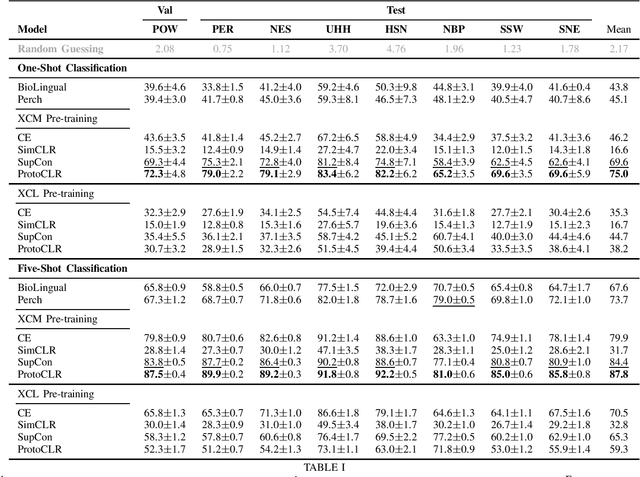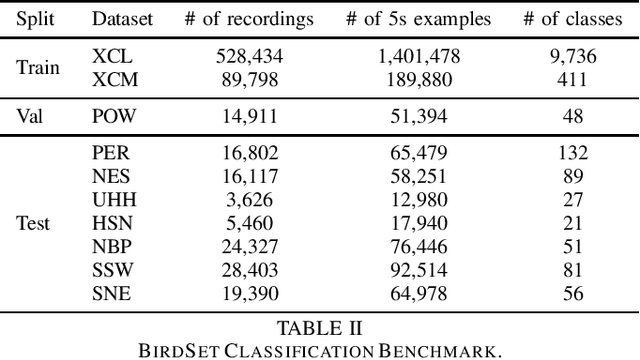Romain Serizel
MULTISPEECH
Posterior Transition Modeling for Unsupervised Diffusion-Based Speech Enhancement
Jul 03, 2025Abstract:We explore unsupervised speech enhancement using diffusion models as expressive generative priors for clean speech. Existing approaches guide the reverse diffusion process using noisy speech through an approximate, noise-perturbed likelihood score, combined with the unconditional score via a trade-off hyperparameter. In this work, we propose two alternative algorithms that directly model the conditional reverse transition distribution of diffusion states. The first method integrates the diffusion prior with the observation model in a principled way, removing the need for hyperparameter tuning. The second defines a diffusion process over the noisy speech itself, yielding a fully tractable and exact likelihood score. Experiments on the WSJ0-QUT and VoiceBank-DEMAND datasets demonstrate improved enhancement metrics and greater robustness to domain shifts compared to both supervised and unsupervised baselines.
Description and Discussion on DCASE 2025 Challenge Task 4: Spatial Semantic Segmentation of Sound Scenes
Jun 12, 2025Abstract:Spatial Semantic Segmentation of Sound Scenes (S5) aims to enhance technologies for sound event detection and separation from multi-channel input signals that mix multiple sound events with spatial information. This is a fundamental basis of immersive communication. The ultimate goal is to separate sound event signals with 6 Degrees of Freedom (6DoF) information into dry sound object signals and metadata about the object type (sound event class) and representing spatial information, including direction. However, because several existing challenge tasks already provide some of the subset functions, this task for this year focuses on detecting and separating sound events from multi-channel spatial input signals. This paper outlines the S5 task setting of the Detection and Classification of Acoustic Scenes and Events (DCASE) 2025 Challenge Task 4 and the DCASE2025 Task 4 Dataset, newly recorded and curated for this task. We also report experimental results for an S5 system trained and evaluated on this dataset. The full version of this paper will be published after the challenge results are made public.
Tracking of Intermittent and Moving Speakers : Dataset and Metrics
Jun 11, 2025Abstract:This paper presents the problem of tracking intermittent and moving sources, i.e, sources that may change position when they are inactive. This issue is seldom explored, and most current tracking methods rely on spatial observations for track identity management. They are either based on a previous localization step, or designed to perform joint localization and tracking by predicting ordered position estimates. This raises concerns about whether such methods can maintain reliable track identity assignment performance when dealing with discontinuous spatial tracks, which may be caused by a change of direction during silence. We introduce LibriJump, a novel dataset of acoustic scenes in the First Order Ambisonics format focusing on speaker tracking. The dataset contains speakers with changing positions during inactivity periods, thus simulating discontinuous tracks. To measure the identity assignment performance, we propose to use tracking association metrics adapted from the computer vision community. We provide experiments showing the complementarity of association metrics with previously used tracking metrics, given continuous and discontinuous spatial tracks.
Diffused Responsibility: Analyzing the Energy Consumption of Generative Text-to-Audio Diffusion Models
May 12, 2025Abstract:Text-to-audio models have recently emerged as a powerful technology for generating sound from textual descriptions. However, their high computational demands raise concerns about energy consumption and environmental impact. In this paper, we conduct an analysis of the energy usage of 7 state-of-the-art text-to-audio diffusion-based generative models, evaluating to what extent variations in generation parameters affect energy consumption at inference time. We also aim to identify an optimal balance between audio quality and energy consumption by considering Pareto-optimal solutions across all selected models. Our findings provide insights into the trade-offs between performance and environmental impact, contributing to the development of more efficient generative audio models.
Angular Distance Distribution Loss for Audio Classification
Oct 31, 2024Abstract:Classification is a pivotal task in deep learning not only because of its intrinsic importance, but also for providing embeddings with desirable properties in other tasks. To optimize these properties, a wide variety of loss functions have been proposed that attempt to minimize the intra-class distance and maximize the inter-class distance in the embeddings space. In this paper we argue that, in addition to these two, eliminating hierarchies within and among classes are two other desirable properties for classification embeddings. Furthermore, we propose the Angular Distance Distribution (ADD) Loss, which aims to enhance the four previous properties jointly. For this purpose, it imposes conditions on the first and second order statistical moments of the angular distance between embeddings. Finally, we perform experiments showing that our loss function improves all four properties and, consequently, performs better than other loss functions in audio classification tasks.
A decade of DCASE: Achievements, practices, evaluations and future challenges
Oct 07, 2024Abstract:This paper introduces briefly the history and growth of the Detection and Classification of Acoustic Scenes and Events (DCASE) challenge, workshop, research area and research community. Created in 2013 as a data evaluation challenge, DCASE has become a major research topic in the Audio and Acoustic Signal Processing area. Its success comes from a combination of factors: the challenge offers a large variety of tasks that are renewed each year; and the workshop offers a channel for dissemination of related work, engaging a young and dynamic community. At the same time, DCASE faces its own challenges, growing and expanding to different areas. One of the core principles of DCASE is open science and reproducibility: publicly available datasets, baseline systems, technical reports and workshop publications. While the DCASE challenge and workshop are independent of IEEE SPS, the challenge receives annual endorsement from the AASP TC, and the DCASE community contributes significantly to the ICASSP flagship conference and the success of SPS in many of its activities.
Diffusion-based Unsupervised Audio-visual Speech Enhancement
Oct 04, 2024Abstract:This paper proposes a new unsupervised audiovisual speech enhancement (AVSE) approach that combines a diffusion-based audio-visual speech generative model with a non-negative matrix factorization (NMF) noise model. First, the diffusion model is pre-trained on clean speech conditioned on corresponding video data to simulate the speech generative distribution. This pre-trained model is then paired with the NMF-based noise model to iteratively estimate clean speech. Specifically, a diffusion-based posterior sampling approach is implemented within the reverse diffusion process, where after each iteration, a speech estimate is obtained and used to update the noise parameters. Experimental results confirm that the proposed AVSE approach not only outperforms its audio-only counterpart but also generalizes better than a recent supervisedgenerative AVSE method. Additionally, the new inference algorithm offers a better balance between inference speed and performance compared to the previous diffusion-based method.
Domain-Invariant Representation Learning of Bird Sounds
Sep 16, 2024

Abstract:Passive acoustic monitoring (PAM) is crucial for bioacoustic research, enabling non-invasive species tracking and biodiversity monitoring. Citizen science platforms like Xeno-Canto provide large annotated datasets from focal recordings, where the target species is intentionally recorded. However, PAM requires monitoring in passive soundscapes, creating a domain shift between focal and passive recordings, which challenges deep learning models trained on focal recordings. To address this, we leverage supervised contrastive learning to improve domain generalization in bird sound classification, enforcing domain invariance across same-class examples from different domains. We also propose ProtoCLR (Prototypical Contrastive Learning of Representations), which reduces the computational complexity of the SupCon loss by comparing examples to class prototypes instead of pairwise comparisons. Additionally, we present a new few-shot classification benchmark based on BirdSet, a large-scale bird sound dataset, and demonstrate the effectiveness of our approach in achieving strong transfer performance.
Energy Consumption Trends in Sound Event Detection Systems
Sep 13, 2024Abstract:Deep learning systems have become increasingly energy- and computation-intensive, raising concerns about their environmental impact. As organizers of the Detection and Classification of Acoustic Scenes and Events (DCASE) challenge, we recognize the importance of addressing this issue. For the past three years, we have integrated energy consumption metrics into the evaluation of sound event detection (SED) systems. In this paper, we analyze the impact of this energy criterion on the challenge results and explore the evolution of system complexity and energy consumption over the years. We highlight a shift towards more energy-efficient approaches during training without compromising performance, while the number of operations and system complexity continue to grow. Through this analysis, we hope to promote more environmentally friendly practices within the SED community.
Normalizing Energy Consumption for Hardware-Independent Evaluation
Sep 09, 2024Abstract:The increasing use of machine learning (ML) models in signal processing has raised concerns about their environmental impact, particularly during resource-intensive training phases. In this study, we present a novel methodology for normalizing energy consumption across different hardware platforms to facilitate fair and consistent comparisons. We evaluate different normalization strategies by measuring the energy used to train different ML architectures on different GPUs, focusing on audio tagging tasks. Our approach shows that the number of reference points, the type of regression and the inclusion of computational metrics significantly influences the normalization process. We find that the appropriate selection of two reference points provides robust normalization, while incorporating the number of floating-point operations and parameters improves the accuracy of energy consumption predictions. By supporting more accurate energy consumption evaluation, our methodology promotes the development of environmentally sustainable ML practices.
 Add to Chrome
Add to Chrome Add to Firefox
Add to Firefox Add to Edge
Add to Edge